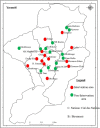High efficacy of microbial larvicides for malaria vectors control in the city of Yaounde Cameroon following a cluster randomized trial
- PMID: 34429446
- PMCID: PMC8385066
- DOI: 10.1038/s41598-021-96362-z
High efficacy of microbial larvicides for malaria vectors control in the city of Yaounde Cameroon following a cluster randomized trial
Abstract
The rapid expansion of insecticide resistance and outdoor malaria transmission are affecting the efficacy of current malaria control measures. In urban settings, where malaria transmission is focal and breeding habitats are few, fixed and findable, the addition of anti-larval control measures could be efficient for malaria vector control. But field evidences for this approach remains scarce. Here we provide findings of a randomized-control larviciding trial conducted in the city of Yaoundé that support the efficacy of this approach. A two arms random control trial design including 26 clusters of 2 to 4 km2 each (13 clusters in the intervention area and 13 in the non-intervention area) was used to assess larviciding efficacy. The microbial larvicide VectoMax combining Bacillus thuringiensis var israelensis (Bti) and Bacillus sphaericus in a single granule was applied every 2 weeks in all standing water collection points. The anopheline density collected using CDC light traps was used as the primary outcome, secondary outcomes included the entomological inoculation rate, breeding habitats with anopheline larvae, and larval density. Baseline entomological data collection was conducted for 17 months from March 2017 to July 2018 and the intervention lasted 26 months from September 2018 to November 2020. The intervention was associated with a reduction of 68% of adult anopheline biting density and of 79% of the entomological inoculation rate (OR 0.21; 95% CI 0.14-0.30, P < 0.0001). A reduction of 68.27% was recorded for indoor biting anophelines and 57.74% for outdoor biting anophelines. No impact on the composition of anopheline species was recorded. A reduction of over 35% of adult Culex biting densities was recorded. The study indicated high efficacy of larviciding for reducing malaria transmission intensity in the city of Yaoundé. Larviciding could be part of an integrated control approach for controlling malaria vectors and other mosquito species in the urban environment.
© 2021. The Author(s).
Conflict of interest statement
The authors declare no competing interests.
Figures





Similar articles
-
Larviciding intervention targeting malaria vectors also affects Culex mosquito distribution in the city of Yaoundé, Cameroon.Curr Res Parasitol Vector Borne Dis. 2023 Jul 28;4:100136. doi: 10.1016/j.crpvbd.2023.100136. eCollection 2023. Curr Res Parasitol Vector Borne Dis. 2023. PMID: 37693015 Free PMC article.
-
The impact of Bacillus thuringiensis var. israelensis (Vectobac® WDG) larvicide sprayed with drones on the bio-control of malaria vectors in rice fields of sub-urban Kigali, Rwanda.Malar J. 2024 Sep 17;23(1):281. doi: 10.1186/s12936-024-05104-9. Malar J. 2024. PMID: 39289705 Free PMC article.
-
Efficacy and persistence of long-lasting microbial larvicides against malaria vectors in western Kenya highlands.Parasit Vectors. 2018 Jul 31;11(1):438. doi: 10.1186/s13071-018-3009-z. Parasit Vectors. 2018. PMID: 30064498 Free PMC article.
-
Bacterial larvicides used for malaria vector control in sub-Saharan Africa: review of their effectiveness and operational feasibility.Parasit Vectors. 2019 Aug 30;12(1):426. doi: 10.1186/s13071-019-3683-5. Parasit Vectors. 2019. PMID: 31470885 Free PMC article. Review.
-
Larvivorous fish for preventing malaria transmission.Cochrane Database Syst Rev. 2017 Dec 11;12(12):CD008090. doi: 10.1002/14651858.CD008090.pub3. Cochrane Database Syst Rev. 2017. PMID: 29226959 Free PMC article. Review.
Cited by
-
Evaluation of a long-lasting microbial larvicide against Culex quinquefasciatus and Aedes aegypti under laboratory and a semi-field trial.Parasit Vectors. 2024 Sep 14;17(1):391. doi: 10.1186/s13071-024-06465-5. Parasit Vectors. 2024. PMID: 39272177 Free PMC article.
-
Larviciding intervention targeting malaria vectors also affects Culex mosquito distribution in the city of Yaoundé, Cameroon.Curr Res Parasitol Vector Borne Dis. 2023 Jul 28;4:100136. doi: 10.1016/j.crpvbd.2023.100136. eCollection 2023. Curr Res Parasitol Vector Borne Dis. 2023. PMID: 37693015 Free PMC article.
-
Level of awareness and utilization of insecticide-treated bed nets among medical students as measures for reducing malaria episodes.Sci Rep. 2024 May 2;14(1):10156. doi: 10.1038/s41598-024-60523-7. Sci Rep. 2024. PMID: 38698066 Free PMC article.
-
Impact of blood meals taken on ivermectin-treated livestock on survival and egg production of the malaria vector Anopheles coluzzii under laboratory conditions.PLoS One. 2024 Aug 15;19(8):e0308293. doi: 10.1371/journal.pone.0308293. eCollection 2024. PLoS One. 2024. PMID: 39146278 Free PMC article.
-
Knowledge, practices and perceptions of communities during a malaria larviciding randomized trial in the city of Yaoundé, Cameroon.PLoS One. 2022 Nov 3;17(11):e0276500. doi: 10.1371/journal.pone.0276500. eCollection 2022. PLoS One. 2022. PMID: 36327271 Free PMC article. Clinical Trial.
References
-
- Guengant J-P, May JF. African demography. Glob. J. Emerg. Mark. Econ. 2013;5:215–267.
Publication types
MeSH terms
Substances
Grants and funding
LinkOut - more resources
Full Text Sources
Medical

